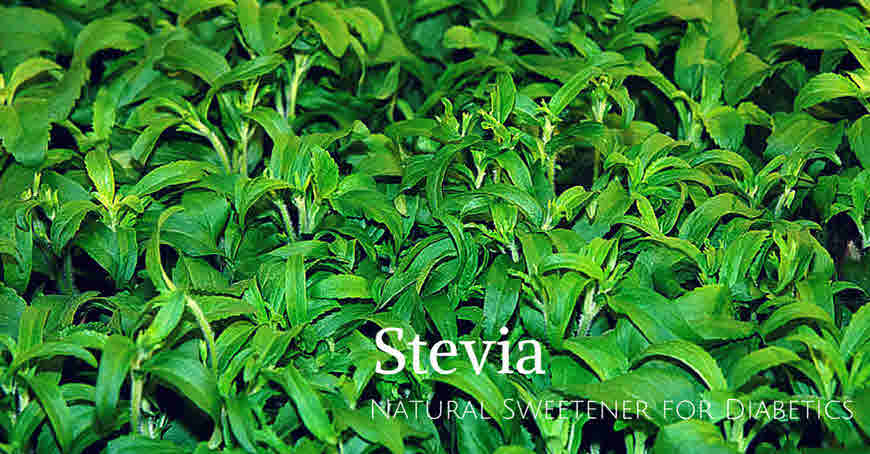Stevia is a natural sweetener without any calorie. It is native to North-eastern Paraguay in South America and now cultivated in China, Brazil, Korea, Mexico, United States, Indonesia, Tanzania and India. Stevia leaves are sweet due to the presence of sweet steviol glycoside which is composed of glucose, sophorose and steviol. It is also known as Stevia, Sweet leaf, Sweet herb of Paraguay, Honey leaf and Candy leaf. The unprocessed leaves of this herb are about fifteen times and the extract (in the form of steviosides) is hundred times sweeter than sugar. It has been used to sweeten tea for centuries. It is hypoglycaemic and used in various parts of world in the management of diabetes.

Botanical name: Stevia rebaudiana Synonym: Eupatorium rebaudianum Bertoni
Family: Asteraceae
The Stevia plant
Semi-humid subtropical perennial semi-shrub up to 30 cm in height;Leaves: sessile, 3-4 cm long, elongate-lanceolate or spatulate shape with blunt-tipped lamina, serrate margin from the middle to the tip and entire below. Upper surface of the leaf slightly glandular pubescent;stem: weak-pubescent at bottom and woody;Rhizome: slightly branching roots;Flowers;composite surrounded by an involucre of epicalyx, capitula in loose, irregular, sympodial cymes, light purple, pentamerous;fruit: five-ribbed spindle-shaped achene.
Some important medicinal properties of Stevia leaves
Due to the presence of phytochemicals Stevia possess medicinal properties. It is sweet due to the presence of glycosides. Since glycoside is not a carbohydrate based molecule so stevia is calorie free. This makes stevia suitable for obese people. Few research show whole leaf concentrate of stevia has regulating effect on pancreas which helps to stabilise blood sugar. Therefore it can be consumed by diabetic people to sweeten the dishes. Stevia is also used traditionally in the high blood pressure, excessive abdominal gas, hyperacidity, nausea and obesity.
Stevia is even used externally. Stevia concentrate is applied to soften, tighten skin, reducing blemishes, acne, eczema, cuts and lip sores.
Following is given important medicinal properties of Stevia
- Works against (Anti-): bacteria, cancer, fertility, diabetes, inflammation.
- Calcium antagonist (reduces influx of calcium into the cells of heart and smooth muscle and thus reduces the strength of contractions, useful to treat angina and high blood pressure)
- Reduces blood sugar level (Hypoglycemic), blood pressure (Hypotensive)
- Contraceptive (prevent pregnancy)
Diseases in which Stevia is useful
Stevia can be safely used as replacement of table sugar in type 2 diabetes. Some studies suggest it has blood sugar lowering effect. Although much data is not available about its safety but it has been in use for hundreds of year in Paraguay and Brazil.
Use of Stevia is beneficial in the following conditions:-
Diabetes, Hyperglycaemia, High Blood Pressure, Inflammation, Water Retention
Available forms of Stevia
Stevia leaves are available in different forms viz. fresh leaves, dried leaves, liquid, tablets, extracts, and powder.
The leaves can be used fresh or dried. The sweetness of dried leaves is more compared to fresh ones. The dried leaves can be used in preparation of tea, drinks and as replacement of table sugar. Like table sugar, these should be added as per taste. The leaves can be used to prepare tea, coffee, curries, muffins, etc.
Stevia liquid concentrates are obtained by mixing extracts in distilled water or ethyl alcohol. Its few drops are sufficient to sweeten the recipes.
Stevia green powder is obtained by pulverising the dried leaves. It is green in color and about twenty times sweeter than sugar. It can be used to prepare drinks and other dishes. Stevia powder has stronger after taste compared to other forms. Stevia white powder is obtained from the extract of stevia. This sweets 300 times to sugar.
Few Stevia Recipes
Stevia can be used in combination with table sugar, honey, jaggery, brown sugar, fruit juice, etc. The extract can be used to sweeten bakery items, smoothies, ice creams, etc. For bakery, stevia should be used along with sugar (as yeast requires sugar). Due to stevia stability at high temperature it can also be added to hot dishes.
Stevia mint infusion
This simple recipe requires crushed dried stevia leaves (1 teaspoon) and crushed dried mint leaves (1 teaspoon). The leaves are soaked in 2 glass water for about 8-12 hours. Then it is filtered and enjoyed chilled by adding ice cubes.
Stevia lemon Lemonade
This is prepared by soaking stevia leaves (1 teaspoon) in water (1-2 glass) for a few hours. This is filtered and added with lemon juice (2-3 lemons).
Contraindications and Side Effects of Stevia
- Safe to use as a sweetener.
- Inadequate data regarding safety in pregnancy and lactation.
- Limited data suggest it may be a contraceptive. Stevia extracts were found to decrease fertility of male rats.
- Liquid leaf extracts significantly decrease plasma glucose levels after overnight fasting in 16 healthy adults.
- Some expert believe Stevia may be hallucinogenic when taken in excess.